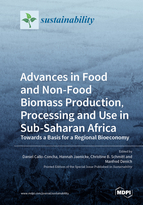Advances in Food and Non-Food Biomass Production, Processing and Use in Sub-Saharan Africa: Towards a Basis for a Regional Bioeconomy
A special issue of Sustainability (ISSN 2071-1050).
Deadline for manuscript submissions: closed (30 September 2018) | Viewed by 135619
Special Issue Editors
Interests: systems thinking for handling complexity; agroforestry, agriculture and rural development; food and nutrition security
Interests: land use and food security; renewable energy; environmental and climate change; ecosystem services; sustainable use of natural resources; biodiversity; urbanization
Interests: biodiversity; food and nutrition security; agroforestry; underutilized crops
Special Issue Information
Dear Colleagues,
The rising global demand for biomass as a source of food, feed, industrial raw materials, and energy is increasing pressure on the agricultural sector. The situation is particularly severe in Sub-Saharan Africa, where many countries struggle to attain food security while facing emerging alternative demands for biomass.
Therefore, it is crucial to safeguard food security and at the same time set the foundation for a prospective regional bioeconomy. This will only be possible by harnessing productivity and efficiency gains throughout the entire biomass-producing, processing and trading system(s).
Related research activities are already ongoing in Ethiopia, Ghana and Nigeria within the framework of the BiomassWeb project (www.biomassweb.org), with a focus on key species of regional and/or national importance, i.e., maize, cassava, plantain/banana/enset and bamboo.
This Special Issue calls for advances in exploring, developing, and testing innovative approaches to produce, process, trade and consume food and non-food biomass in Sub-Saharan Africa. We are interested in studies that highlight approaches to using traditional African crops, cascading uses, recycling of biomass and the use of biomass waste. Studies relevant for developing, modeling, and implementing comprehensive land uses, and bioeconomy strategies for Sub-Saharan African countries and regions are also encouraged. We look forward to learning from studies carried out in other Sub-Saharan countries dealing with crop species beyond those emphasized in the BiomassWeb project. Disciplinary studies, as well as those in which interdisciplinary and participatory approaches were considered and implemented are welcome.
As the current state of development of the related sectors is rather young, prospective-oriented research that explores future possibilities, synergies and trade-offs between and across different biomass uses will be appreciated.
We look forward to your contributions.
References:
El-Chichakli B. et al. 2016. Five cornerstones of a global bioeconomy. Nature 535: 221-223.
German Bioeconomic Council. 2015. Bioeconomy Policy (Part II): Synopsis of National Strategies around the World. A report from the German Bioeconomy Council (GBC). Office of the Bioeconomy Council, Berlin. http://biooekonomierat.de/en/publications/
Schmid O, Padel S, Levidow L. 2012. The Bio-Economy Concept and Knowledge Base in a Public Goods and Farmer Perspective. Bio-based and Applied Economics 1(1):47-63.
Virchow D, Beuchelt T, Denich M, Loos TK, Hoppe M, Kuhn A. 2014. The value web approach – so that the South can also benefit from the bioeconomy. Rural 21, Vol. 48, Nr. 3/2014, pp. 16-18.
Virchow, D., Beuchelt, T.D., Kuhn, A., and M. Denich 2016. Biomass-Based Value Webs: A Novel Perspective for Emerging Bioeconomies in Sub-Saharan Africa. In: Technological and Institutional Innovation for Marginalized Smallholders in Agricultural Development. F.W. Gatzweiler and J. von Braun (Eds.), Springer International Publishing, pp. 225-238. https://link.springer.com/chapter/10.1007/978-3-319-25718-1_14
Sincerely,
Dr. Daniel Callo-ConchaDr. Manfred Denich
Dr. Hannah Jaenicke
Dr. Christine B. Schmitt
Guest Editors
Manuscript Submission Information
Manuscripts should be submitted online at www.mdpi.com by registering and logging in to this website. Once you are registered, click here to go to the submission form. Manuscripts can be submitted until the deadline. All submissions that pass pre-check are peer-reviewed. Accepted papers will be published continuously in the journal (as soon as accepted) and will be listed together on the special issue website. Research articles, review articles as well as short communications are invited. For planned papers, a title and short abstract (about 100 words) can be sent to the Editorial Office for announcement on this website.
Submitted manuscripts should not have been published previously, nor be under consideration for publication elsewhere (except conference proceedings papers). All manuscripts are thoroughly refereed through a single-blind peer-review process. A guide for authors and other relevant information for submission of manuscripts is available on the Instructions for Authors page. Sustainability is an international peer-reviewed open access semimonthly journal published by MDPI.
Please visit the Instructions for Authors page before submitting a manuscript. The Article Processing Charge (APC) for publication in this open access journal is 2400 CHF (Swiss Francs). Submitted papers should be well formatted and use good English. Authors may use MDPI's English editing service prior to publication or during author revisions.
Keywords
- biomass
- production processing and trade
- utilization
- value chain
- value web
- food and nutrition security
- waste
- recycling
- energy
- bioeconomy
- Africa
- land-use strategies






